![]()
![]()
![]()
Use LEFT and RIGHT arrow keys to navigate between flashcards;
Use UP and DOWN arrow keys to flip the card;
H to show hint;
A reads text to speech;
40 Cards in this Set
- Front
- Back
|
Between Cell Divisions, DNA is long and stringy and exists as |
Chromatin. |
|
|
DNA makes a ____ of itself before cell division. |
copy. |
|
|
In eukaryotes, the DNA wraps around proteins to make a compact structure called __________ |
chromosomes. |
|
|
The two copies of DNA make up the two identical halves of chromosomes. Each half is called a ___________ |
Sister Chromatid. |
|
|
The two chromatids are attached at a point called a __________ |
Centromere. |
|
|
When the cell divides, each of the two new cells will receive one chromatid from each __________ |
Chromosome. |
|
|
Humans have __ pairs of chromosomes for a total of __ chromosomes in each cell's nucleus. |
23 and 46. |
|
|
The structure of a chromosome (know centromere and chromatids.) |
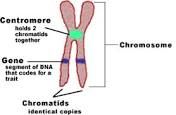
|
|
|
____ ________ is the process by which cells reproduce. |
Cell Division. |
|
|
______ _______ is the process of cell division in eukaryotes. |
Binary Fission. |
|
|
______ is the process of cell division in eukaryotes. |
Mitosis. |
|
|
Mitosis results in 2 new cells with genetic material that is _________ to the genetic material of the original cell. |
Identical. |
|
|
Mitosis occurs in organisms undergoing ______, ___________, ______, or ________ ___________ |
Growth, Development, Repair, or Asexual Reproduction. |
|
|
_______ Reproduction is the production of offspring from one parent. |
Asexual. |
|
|
One example of asexual reproduction is ______ _______ seen in bacteria. |
Binary Fission. |
|
|
The ____ ______ is the repeating set of events in the life of a cell. |
Cell Cycle. |
|
|
The time between cell division is called __________. |
Interphase. |
|
|
__________ consists of three phases: a)_________ b)_________ c)_________ |
Interphase a) growth b) replication c) of the DNA (synthesis) |
|
|
Mitosis is the division of the _______, which occurs during cell division. |
Nucleus. |
|
|
Mitosis is divided into 2 stages. What are these stages? |
Prophase, Metaphase, Anaphase, and Telophase. |
|
|
Mitosis results in _ daughter cells that are genetically identical to the original |
2. |
|
|
_______ is the first phase of mitosis. |
Prophase. |
|
|
a) Chromatin condenses to form ___________. b) The nucleolus and the nuclear membrane break down and _________. c) In animal cells, cylindrical bodies called centrioles appear which produce _______ ______. |
a) Chromosomes b) Disappear c) Spindle Fibers. |
|
|
Prophase: |
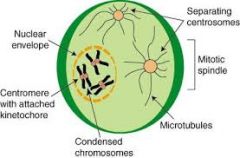
|
|
|
________ is the 2nd phase of mitosis. |
Metaphase. |
|
|
a) Spindle fibers attach to the __________ of the chromosomes and move them to the center of the dividing cell. |
Centromere. |
|
|
Metaphase: |
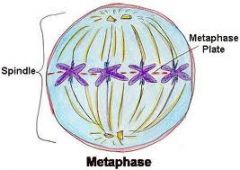
|
|
|
The fourth step of Mitosis is ________. |
Telophase. |
|
|
a) The spindle fibers disassemble b) the chromosomes return to a less tightly coiled _________ state. c) A _______ envelope forms around each set of chromosomes, and a nucleolus forms in each of the newly forming cells. |
b) Chromatin. c) Nuclear. |
|
|
Telophase: |
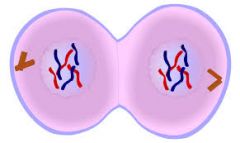
|
|
|
During __________ in animal cells, a ______________ pinches in and eventually separates the dividing cell into two cells. |
Cytokinesis, and Contractile Ring. |
|
|
In plant cells, a ____ _____ separates the dividing cell into two cells. |
Cell Plate. |
|
|
Cytokinesis in animal cells: |
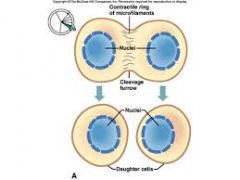
|
|
|
Cell division in Eukaryotes is controlled by ________ called cyclins. |
Proteins. |
|
|
______ may result if cells do not respond to control mechanisms and continue to divide nonstop. |
Cancer. |
|
|
ORGANIZATION OF LIVING THINGS: |
Will be in the next slide! |
|
|
When the same type of cells normally divide to make a group of cells that perform the same function, they form a ______. |
Tissue. |
|
|
A group of tissues that work together form an _____. |
Organ. |
|
|
A group of Organs that work together form an _____ ______. |
Organ System. |
|
|
All of the organ systems together form an ________. |
Organism. |

